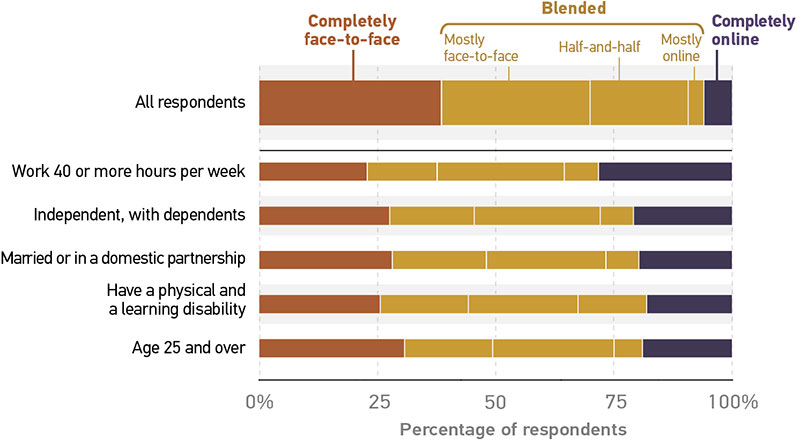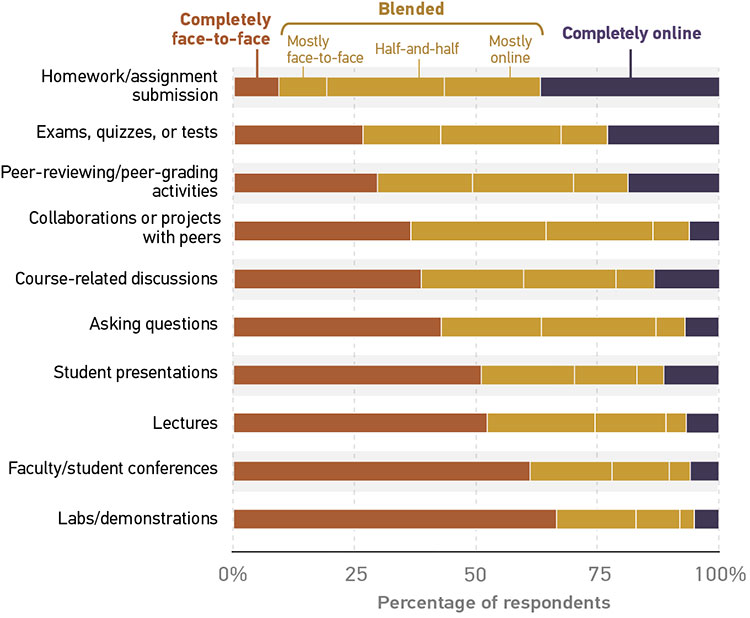Learning Environment Preferences
Do students prefer face-to-face, blended, or online? Well, it depends....
Student populations on US college and university campuses are becoming more diverse, and this trend is expected to continue well into the 2020s.1 As Ted Mitchell of the American Council on Education (ACE) has pointed out, the new "normal" student is not fresh out of high school but is instead "just as likely to be a twenty-five-year-old returning veteran, a thirty-year-old single parent, or a fifty-three-year-old displaced worker who is looking to reskill and retrain."2 And our findings this year suggest that these student demographics and enrollment trends are factors that can influence the kinds of learning environments students prefer and select when taking their courses.
About half of respondents (56%) said they prefer some form of blended learning3 for their classroom environments—neither fully face-to-face nor fully online—and this preference was consistent across institutional type and size, as well as student ethnicity and gender. Looking more closely, however, we find that student preferences strongly lean (70%) toward in-person environments. Two in five students (38%) told us they prefer courses that are solely face-to-face, and another third (32%) favor settings that are mostly face-to-face. This finding suggests that students value the interactions with instructors and peers that can come with courses held in brick-and-mortar classrooms. In contrast, only a small percentage of students (9%) reported preferring environments that are mostly or completely online, and these inclinations could be driven by their work and family obligations.
Preferences Can Depend on Life Outside the Classroom
Which students are inclined toward online environments? When we explored key demographic factors, we found that respondents who were married or in a domestic partnership, those who were independent and had dependents of their own, and students who worked 40 or more hours a week were more likely than their peers to prefer environments that are mostly or completely online. Students age 25 and older and individuals who identified as having both a physical and a learning disability that require technology for their coursework also had a stronger preference for classes that are primarily or fully online (figure 1).

To learn more about their experiences in online environments, we asked students if they had taken any courses that were entirely online in the past year. Half (51%) of our respondents said some of their courses were taken fully online, while only 6% said all of their courses were completely online. Among all students, more women, Hispanic/Latinx, and black students reported taking some of their courses completely online than taking either all or none of their classes online. We also found that more married students, students who are independent with dependents (e.g., children or other family members), those with a physical disability, and those with both a physical and a learning disability took all of their courses fully online. These findings shed additional light on why these particular environments might be the first choice for students who have individualized needs. Online courses are likely a more practical choice for students who are working long hours and aren't able to get to campus for class. These environments can also afford students more flexibility when attending to parenting and caregiving responsibilities. Fully online classes can also be logistically easier for students with disabilities, especially for those with mobility issues who have challenges with transportation and/or the physical navigation of a brick-and-mortar campus, as well as individuals with chronic conditions that impede in-person attendance.
Preferences Also Depend on the Activity or Assignment
What about the activities that actually take place in those courses? Do students have a learning environment preference for how they submit assignments, take a test, or collaborate with peers? To better understand student attitudes about how they engage with a particular task, we asked them to tell us their preferred environments—from strictly face-to-face, to completely online, or somewhere in between—for the kinds of activities they would do in a typical class. Our results suggest that their predilections can differ on the basis of the learning task itself, and we found considerable agreement on their preferences for face-to-face settings for particular activities. Labs/demonstrations was the most preferred activity for a completely face-to-face environment, with 67% of respondents rating it at the top, followed by faculty/student conferences (61%), and lectures (52%) (figure 2). Labs or demonstrations and conferencing in face-to-face settings can provide opportunities for real-time conversation, immediate feedback, and clarification. These activities were also rated among the least preferred for completely online environments, which suggests that many students value having these particular experiences in person and that they are looking for opportunities to have engaging interactions with their instructors and peers during class. Examples from many qualitative responses4 from students this year demonstrate that they see an in-class lecture as a site where meaningful connections can be made with their instructors, classmates, and the material and that technology is a conduit for those connections. But they want to be more than in-class spectators:
- "I want my professors to stop reading PowerPoint slides word-for-word off of a screen, and to start using the technology at hand to create a different kind of lecture that will engage their students in the learning process."
- "I'd love for there to be more interactive polling and questions during class. Even though I don't like the idea of being in lecture every day, that would keep me more engaged if the instructors were more dynamic with their tech use."
- "Integrate [technology] more into lectures. It's very difficult to sit and watch you talk. Technology can be so beneficial to learning if used in the right ways to enhance and complement lectures. Use collaborative quizzes (Kahoot, etc.), let us research in class, etc."
- "Provide more online learning tools such as interactive lectures where people on laptops or tablets can also engage with the material being presented."

At the other end of the learning environment spectrum—online-only settings—homework/assignment submission (37%), exams, quizzes, or tests (23%), and peer-reviewing/peer-grading (19%) were the three most preferred activities. However, it is worth noting that, overall, far fewer students said they preferred completely online to completely face-to-face settings for the activities we asked about. Our results indicate the majority of students like some form of blended environment for collaborations or projects with peers (57%), homework/assignment submission (54%), peer-reviewing/peer-grading (52%), exams, quizzes, or tests (51%), and asking questions (50%).
To turn these findings into action, instructors can take a more student-centered approach when choosing an environment for a particular learning task. Incorporating active learning strategies that integrate technology (such as online collaborative quizzes and polling) into traditional lectures and labs offers opportunities to engage students and maximizes face time with instructors and peers. With online and blended learning rated No. 2 in the 2019 Key Issues in Teaching and Learning, it's clear that higher education community members see the importance of working in this area. With this in mind, faculty can collaborate with instructional designers to identify opportunities to leverage online and blended environments. For example, greater utilization of the institution's learning management system (LMS) for the submission and evaluation of assignments could benefit students with mobility disabilities, who could conduct these activities without needing to get to and from campus. As one student noted in our survey, "turning in homework online would be ideal considering walking is exhausting [and] my physical disabilities keep me home a lot." But when we consider accessible and universal design for learning (voted No. 5 in ELI's key issues for 2019), such a practice becomes a "curb-cut"5 for the classroom. That is, just as sidewalk curb cuts—designed to aid individuals using wheelchairs—also benefit those with strollers and rolling luggage, submitting assignments online can be helpful and have a positive impact on all learners: the student at home with the flu, the mother who has childcare issues, or the part-time student who must work an extra shift.
Notes
-
Nathan D. Grawe, "How Demographic Change Is Transforming the Higher Ed Landscape," Higher Ed Jobs, February 18, 2019; Eric Hoover and Beckie Supiano, "A Population in Flux Forces Colleges to Adapt," Chronicle of Higher Education, December 16, 2016.
↩︎ -
Ted Mitchell, "Changing Demographics and Digital Transformation," EDUCAUSE Review 54, no. 1 (Winter 2019), 10–17.
↩︎ -
We take our definition of "blended" from the work of Means, Bakia, and Murphy, who contend that the forms of blended learning "encompass all of the middle ground in the spectrum between fully face-to-face and fully online instruction." See Jeffrey Pomerantz, Malcolm Brown, and D. Christopher Brooks, Foundations for a Next Generation Digital Learning Environment: Faculty, Students, and the LMS, research report (Louisville, CO: ECAR, January 2018); Barbara Means, Marianne Bakia, and Robert Murphy, Learning Online: What Research Tells Us About Whether, When and How (New York: Routledge, 2014), 7.
↩︎ -
Students were asked the open-ended question, "What is the ONE thing you would like your instructors to do with technology to enhance your academic success?"
↩︎ -
Christopher Phillips, "Online Course Accessibility to Benefit Everyone," EDUCAUSE Review, September 28, 2018.
↩︎